#can you tell i reject the auteur theory
Text
directy directory ramble incoming
I wanted to type out my thoughts on the role of director and how its viewed. Especially coming from a perspective of seeing the streaming bubble pop and just..intense scope creep..and yeah , anyway. No reason specifically just my surface level musings that i always have.
Its been 5+ years since I went from an animation supervisor to an animation director, to being able to do my own episodes. It wasnt something I wanted in the sense of a title, but I just like taking whatever the next step or challenge is. I've always been team oriented too, so that will always be in the back of my mind when being in a position with more power. The level of power you have as a director is not something I was expecting to have,so I try not to take it for granted.
Over time I really found that there are two viewpoints of what the job and the expectations of the director are. People have asked me for advice on the job and Its through these conversations that I really see the split opinion.
The strongest camp is the one that represents the word least to me, and thats the people who think that the director is 'in charge' in the sense of always doing what they say. There are good and bad of course, but the directors job is to make the hard choices and to push boundaries and to enact a VISION (be it their own, a clients, ect). Their expectation soley revolves around the creation of the creative product.
The other camp is the one that sees the Director as a leader first and foremost, who has a responsibility to their team as well as the product, and that leadership and team management skills should be on the roster as well as creative prowess.
one thinks its about creative vision first and minimal people skills, and the other thinks it should be 50/50 at the very least.
I'm in the second camp, and I have so many people that go 'YES, THAT IS WHAT A DIRECTOR SHOULD DO!' and as much as I agree, I also have to point out that is often not the actual reflected expectations that Directors get - expectations play a big role after all. When you enter a job or grow in a job you should know what your new responsibilities are, and if not you are left to fill in your own gaps.
Studios in GENERAL are terrible with clear boundaries and job expectations, so its really no surprise that the stronger creative voices become the loudest in the room. Even the most well meaning people can get into an impossible mindset because no one has told them otherwise...we all know passion and creativity can take us places after all. Sometimes, one is thrust into a position of power without even knowing just how much their choices may impact the team. There are some notorious asshole directors of course but for the most part I've found that creatives in the director realm are well meaning. However, that doesnt change the reality that as well-meaning as you are, there is an entire team of people who can be effected by your mindest, choices and problem sovling for good or bad.
I've talked about this before, but a mindset can vastly change how you problem solve something. A director with no leadership skills may see work that does not meet their expectations and their first thought was that the artist did not do their job properly. A director with leadership skills may see work that does not meet their expectations and understand there are many factors. Heres a few questions I ask myself.
did that person receive proper expectations for the task ?
was there a communication mishap ?
( this happens ALL THE TIME. its ART !_! the amount of times i've written a note that i thought was super clear and someone takes it in a way that..i didnt expect but it also made sense ? SOMETIMES IT DO BE THAT WAY. WE WORK ON OUR COMMUNICATION SKILLS TOGETHER)
did they have enough time to do it ? or feel rushed?
is everything ok ? Everyone has bad times and blips in the production so its reasonable that sometimes things come in not 100%
if it is a hard skill issue, is it a one off or is it ongoing? how are we helping them work on it?
The answers to these questions are FAR more valuable in actually getting your vision done to the best of your time and energy then just simply thinking someone doesnt have the skills or needs to learn more.
ALL OF THIS TO SAY. That even just having good faith and a connection to your team as a director is incredibly valuable for your information gathering and problem solving, (you learn way more about your pipeline and where the real issues are.) but is vastly underrepresented as an expectation of the job. SO.
IF YOU WANT TO DIRECT. you may not get told that your team is part of your responsibility, but if we want a sustainable and healthy industry we have to divide our passion for the project into our team as well as the creative end game. Take some leadership classes, learn about different communication types, or at least have people around you who can do that. You dont need to be everyones bestie, but you do have a responsibility for their experience on the project.
ill post some tips and such about working with people later cuz this is long enough
#people who read this who go the heck#thats just basic isint it?#yes yes it is come and join me and we can feel gaslit in this industry together#long story short dont assume your directors or supervisors got any training on how to communicate or manage projects with lots of ppl#can you tell i reject the auteur theory#director rambles#animation industry
53 notes
·
View notes
Text
On Rian Johnson
Rian Johnson has written at least one movie that I consider absolutely perfect (his debut feature film, Brick (2005)). Also Looper (2012) was possibly the only mind bending sci-fi blockbuster I've ever seen. (Remember how people talked about Inception? Looper was everything Inception promised and failed to deliver.)
I thought he actually DIRECTED a beautiful film. The cinematography was amazing. It supported some beautiful editing and worked with the cinematic nature of the medium to generate the emotional intensions of the scenes.
As for the writing...
Please consider this article from the LA Review of Books:
“...Johnson makes his whole film revolve around characters’ fear of repeating the past, and both the attraction and the risk of breaking away from tradition. [...] But the real and lasting masterstroke in Johnson’s truly invigorating film is the way it connects the rejection of the Jedis’ patriarchal tradition to the roles played by women in the narrative. [...] Not content to merely include competent female action heroes like Rey or authoritative female leaders like General Leia Organa, Johnson’s film repeatedly opposes male characters’ impulsive and presumptuous actions with alternatives supplied by their female counterparts.”
And furthermore, if Rian Johnson is really mucking things up by introducing continuity errors or breaking with established arcs and character directives, then there should be someone there to stop him from making those moves. No Hollywood blockbuster is the result of one person’s choices. An executive producer can demand a total restructuring of a film which fundamentally alters the essence of a film.
(For example, the 2008 Vin Diesel action film Babylon A.D. was directed by Mattieu Kassovitz the auteur behind the 1995 French drama about race and class relations in Paris La Haine and based on a 1999 French-language science fiction novel Babylon Babies published by the reknown critical theory and philosophy publisher Semiotext(e). At the demand of the executive producer it was stripped of any meaningful content and editing into a mediocre adrenaline ride which hinted at a much more interesting story being told somewhere behind the scenes. Ultimately, Kassovitz himself described the movie as “all violence and stupidity.”)
Comic books have been having multiple authors working on the same characters and worlds simultaneously for literal decades. The solution is that you have a character or series editor who is responsible for ensuring continuity and directing the general arc of the characters and their evolution, while giving the authors and artists relative freedom to tell the stories they want.
It seems as reasonable to me to blame Rian Johnson for the overall decisions made regarding the plot and character arcs as it is to give him credit for the design of the Porgs. He’s just one man inside a much larger and more complex machine. If he alone was able to create that much destruction on a billion dollar franchise, then someone else fell down on their job.
TL;DR:
I don’t think it’s fair to blame Rian Johnson for everything that “wasn’t right” about TLJ and also I think the creative team made a number of really brave and important choices and decisions challenging the patriarchal and fascist narratives that were baked-in to the original Star Wars mythos.
#unpopular opinion#star wars#the last jedi#rian johnson#film criticism#about me#la review of books#larb#long post#sorry not sorry#movie recommendations#please don't kick me out of the fandom#i just got here
4 notes
·
View notes
Text
Press: Why the Women of Top of the Lake Are Laughing in the Face of Male Complaints
“They’re asking for too much, these dudes.”
VANITY FAIR – A brief cloud crosses actress Gwendoline Christie’s face when I asked her if she thinks her Top of the Lake: China Girl character—the hopeful, open-hearted officer Miranda Hilmarson—bears a close resemblance to her real-life persona. Anyone who has watched Christie in interviews or on a red carpet knows that the six-foot-three blonde—who made a name for herself playing severe, lethal characters like Brienne of Tarth on Game of Thrones, Commander Lyme in The Hunger Games, and Captain Phasma in the latest Star Wars trilogy—is, in actuality, one of the friendliest and easy-to-smile actresses in the business.
That goofy side is on display for the first time in Christie’s decade-long career in a role that Top of the Lake creator Jane Campion wrote specifically for her. Hilmarson will stoop to make friends with a dog, and does her best to crack the hard nut that is Elisabeth Moss’s Robin Griffin. But Christie is still right to distance herself a bit from Hilmarson—because, like everything in Campion’s work, this bright and cheery constable has a darker side.
Moss herself is fond of repeating Campion’s thesis statement for creating Top of the Lake, an ongoing dark feminist drama disguised as a crime story which follows Detective Griffin from a small New Zealand town in Season 1 to the faster-paced dangers of Sydney, Australia, in Season 2. “The placid lake of Season 1,” Moss says, paraphrasing Campion, “hides the danger underneath. But while Season 1 dealt with the wildness without, this year we’re tackling the wildness within.” And indeed, the second season of the critically acclaimed drama—which airs six new episodes on three consecutive nights starting Sunday, September 10, on Sundance—brilliantly juxtaposes the gray, ordered facade of a city like Sydney with the messy, violent passions of the people who inhabit it.
Still licking her wounds from the trauma of Season 1 (the loose ends of which are brilliantly tied up via heartbreaking flashback and a harrowing guest appearance in Season 2), Robin once again serves as avenging angel—this time for a young Asian sex worker who washes up on a Sydney beach inside a suitcase. “Hello, darling,” she murmurs to the mutilated corpse. “Do you want to tell me what you saw?” But while Griffin has always had an easier time tenderly connecting with the dead, the second installment of the series pushes her, hard, out of her comfort zone when she is reunited with Mary, the long-lost teenaged daughter whom she gave up for adoption (played by Campion’s real-life daughter Alice Englert) and Mary’s parents (played by Nicole Kidman and Ewen Leslie).
In Mary, a role also specifically written for the actress who plays her, Campion has outdone herself in her ongoing exploration of duality, darkness, and femininity. A smart, damaged, vulnerable, hard-to-love teen, Mary finds herself wrapped up in the case of Robin’s dead girl and dares the audience to sort her into either the hero or villain category. She defies definition, which ultimately is Campion’s finest gift for all of the women in Top of the Lake. “When I took on the role,” Englert says of that at-times monstrous, at-times vulnerable Mary, “I felt like that was my challenge—to root for her. And I didn’t know if anyone else would, to be honest.”
Once I had seen the full season of Top of the Lake: China Girl (Sundance initially only set three episodes), I understood Christie’s reluctance to identify too closely with Constable Hilmarson. “I enjoy playing humor very much,” she admits, “but I would hope that I’m not as dark and sad as Miranda is, or struggling with life as much as she is. But she is a character with an open heart, and that is a joy to watch and a joy to play.” Moss also rejoices in getting to play Detective Griffin once more—a role that did a lot to change audiences expectations of what a petite and wide-eyed actress like her can bring to a part like this. TV lovers are quite accustomed, now, to Moss’s steelier edge, having watched her grimly stare down the camera for 10 episodes of The Handmaid’s Tale. But way back in 2013, Campion was the first filmmaker to really tap into the dark, messy potential of an actress then best known for playing good girls like the president’s daughter on The West Wing or Don Draper’s protégé (with, O.K., a slight edge) in Mad Men.
How does Jane Campion write such messy, complicated, hard-to-define women? Easy, Moss says. “Every character is an avatar of Jane. Every single one.” When I run this theory by Englert, she laughs in delight. “Yeah—now that you say, what I love about my mom is that sometimes she reminds me of that special energy and passion that you have. That fight in you at like, 12. Hormones haven’t hijacked you and manipulated all of your energy into ridiculous pursuit of procreation. You can see the adult world, but you’re not part of that yet. My mom reminds me of that.”
But for all the room Campion gives her female characters—space to be disasters capable of tight control, or monsters capable of tender heroism—she doesn’t quite afford the male characters of Top of the Lake: China Girl the same dimensionality. Almost every single male character, from customers in the brothel to Mary’s piggish, too-old boyfriend, Robin’s sexist colleagues, her somewhat selfish brother, and her wrapped-up-in-the-murder boss, is either an outright villain, an exploration of frustrated male sexuality, or someone caught in arrested development. There are scant men, other than Mary’s dad, Pyke, worth rooting for. And most of the compelling relationships in Top of the Lake: China Girl are between two women—either mother and daughter or female colleagues. In other words, as Englert puts it, the female issues that are usually the “side salad” of most films and TV (especially in the crime genre) are the “main course” of Top of the Lake.
Rather than reject this critique of the men in Top of the Lake—initially brought to my attention by a male TV critic—Moss and Christie gleefully embrace it. “Another man pointed it out to me,” Moss responds, laughing. “I didn’t notice it either.” Pointing out that it’s usually women who fill the two-dimensional roles while men have the meatier parts to chew on, Moss teases that Top of the Lake was a “taste of your own medicine. How’s that?” Christie also had to have this phenomenon pointed out to her. “I hadn’t noticed at all. A good friend of mine actually said: ‘There is not one likable male character in this.’” Grinning devilishly, she continues: “That’s unlikely, isn’t it? We don’t normally see that in our TV dramas, do we?”
Only Englert is willing to stick up for at least one of her male co-stars. “Pyke is a lovely man! He’s a beautiful character,” she says, heaping praise on her TV dad. He’s played with passive, bearded charm by Ewen Leslie, though some might argue that Pyke is neutered by the fact that his wife (Kidman’s brusque and insecure Julia) has left him for another woman. He’s also constantly capitulating to his willful daughter. And Englert also concedes that there are no unalloyed heroes (of either gender) to be found in Top of the Lake. “I find it really interesting that men want to be so liked. They have to be perfect to be a likable character. It’s like, get used to it. You can be imperfect and still be interesting. They’re asking for too much, these dudes.”
It’s the art of imperfection that Campion has truly perfected in Top of the Lake’s shaggy second season. The mystery of the girl in the suitcase resolves itself, improbably, much the way the first season mystery did, via coincidence and too many connections to Robin’s personal life. But that’s because Campion isn’t as interested in the mystery as she is in the striving, failing, complicated women caught in its orbit. Top of the Lake goes well over the top at times to highlight cartoonish male villainy, and has zero qualms about leaving certain threads dangling. But at its beating heart, this is a story of a girl caught between two mothers—which Campion can’t help but make intensely personal by casting her own daughter at the center of this unconventional love triangle, and drafting two of the finest working actresses to play different versions of herself. “What great auteurs do, in my opinion, is show you their vision about what it is to be human,” Christie concludes. In other words, this is just Jane’s world—and we’re all lucky to be in it.
Press: Why the Women of Top of the Lake Are Laughing in the Face of Male Complaints was originally published on Glorious Gwendoline
#gwendoline christie#game of thrones#got cast#Brienne of Tarth#star wars#Captain Phasma#The Force Awakens#Mockingjay 2#Commander Lyme#THG#The Hunger Game
4 notes
·
View notes
Text
M. Creative Investigation Planning - Source Review Sheet 9
Name of Book / Magazine: Notes on Auteur Theory in 1962
Author: Andrew Sarris
Publisher, place of publication and date: 1962
Title of chapter / article: Notes on Auteur Theory
Page numbers used: 35, 39, 40, 42, 43, and 44
Web address used to access source: N/A
Date Accessed: 04/10/2017
Your research topic / question: Director Study of Tim Burton. This will include the sub-topics: Style, Themes, and Collaborations. For the quotes I have gathered, I will specify which topic they fall under. When I come to writing my creative investigation, this should certainly make the process easier.
Brief overview of what the article / chapter / book is about: In 1962, acclaimed film critic Andrew Sarris wrote a piece discussing the Auteur Theory. This was one of the influential discussions that lead many people to see both sides of the argument.
Key quotes from article / chapter / book that relate to your topic:
1. “...seems to reduce the auteur theory to a game of aesthetic solitaire with all the cards turned face up. By auteur rules, the Fords will come up aces as invariably as the Kings will come up deuces. Presumably, we can all go home as soon as the directorial signature is flashed on the screen.” p.g. 35
2. “If a director fails to keep pace with the development of his medium, his work will become obsolescent.” p.g. 39
3. “How can one review an Anthony Mann western, Bazin asks, as if it were not an expression of the genre’s conventions. Not that Bazin dislikes Anthony Mann’s westerns that the auteur theory rejects because their directors happen to be unfashionable. Again, Bazin’s critical generosity comes to the fore against the negative aspects of the auteur theory.” p.g. 39
4. “The writer-hero in Sunset Boulevard complains that people don’t realise that someone “writes a picture; they think the actors make it up as they go along.” It would never occur to this writer or most of his colleagues that people are even less aware of the director’s function.” p.g. 40
5. “...I feel that the auteur theory is the only hope for extending the appreciation of personal qualities in the cinema. By grouping and evaluating films according to directors, the critic can rescue individual achievements from and unjustifiable anonymity.” p.g. 42
5. “A great director has to be at least a good director. This is true in any art. What constitutes directional talent is more difficult to define abstractly. There is less disagreement, however, on this first level of the auteur theory than there will be later.” p.g. 43
6. “Over a group of films, a director must exhibit certain recurring characteristics of style, which serves as his signature. The way a film looks and moves should have some relationship to the way a directors are generally superior to foreign directors. Because so much of the American cinema is commissioned, a director is forced to express his personality through the visual treatment of material rather than the literary content of the material.” p.g. 43
7. “Nowadays, it is possible to become a director without knowing too much about the technical side, even the crucial functions of photography and editing. An expert production crew could probably cover up for a chimpanzee in the director’s chair. How do you tell the genuine director from the quasichimpanzee? After a given number of films, a pattern is established.” p.g. 44
0 notes
Text
Auteur Theory - Alex Stoddard
Alex Stoddard is a surrealist photographer known for his eerie images and self-portraits. Most of the work that Alex does is portraits that tell a story in some way. He began experimenting with photography at 16 in his backyard in Georgia where he would take self-portraits. After sharing his work with the world by posting it on Flickr Alex gained thousands of followers and decided to take his photography to the next level. Alex is currently 23 and lives in Orange, California where he works in photography.
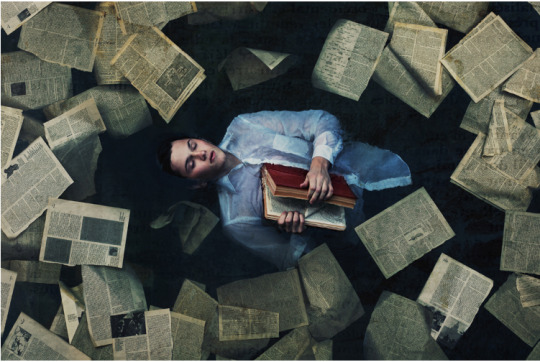
“Slip Away”
The photographs that Alex takes are very strange and eerie, keeping in mind that Alex is a surrealist artist. Almost all of Alex’s images are extremely dreamlike and induce a sense of delusion; to me, the photos create perfect balance of calm and anxiety. Seeing such peculiar depictions of reality often causes discomfort and I believe that to be Alex’s goal. Although I feel as though I am looking at these images through glass because of the filter, this makes me feel safe although the subjects are so grotesque. One of the main attributes of Alex Stoddard’s style is to create a very hypnogogic feel, making the viewers reach deep into their imaginations to bring out the story.
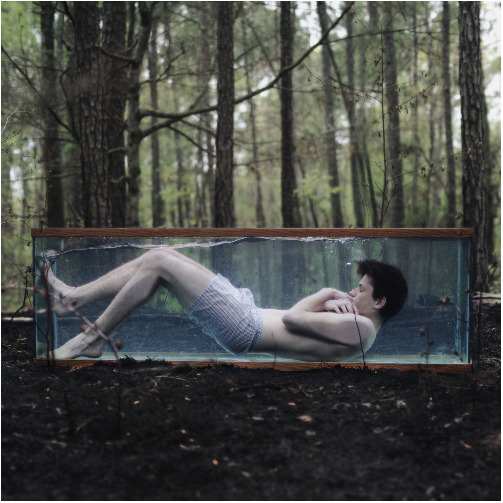
“Sanctuary”
Within Alex’s work he expresses stories in many ways whether it be a story that he created, one that already exists or a one liner. Sometimes the stories are scripts that everyone knows but aren’t specific to an author such as; a child stolen by a dark figure or a mermaid on the rocks. One of Alex’s photos that have a simpler meaning such as ‘To Beg for a Tide’.

Another image I chose to represent how Alex tells stories in his work is ‘The Spark’ this is also one that is quite self-explanatory. Here it shows to people just gently touching fingers and there is a lightning bolt running through. So obliviously the deeper meaning to this photo is two people in love or maybe having that moment where; ‘sparks fly’.

This next photo is less of a one liner such as the others, but it does also tell a story that people seem to know; this is, the child and the evil witch. This photo is not individually titled but it is from a series names ‘Tiny Fluttering Wings’. The innocence of the title is quite eerie because of how dark the actual series is. This is a story of a child’s soul being devoured by the witch, the witch stealing every little butterfly of dreams and innocence. This story is one that we know, the darkness feeding on a child’s light, but it is executed so creatively.
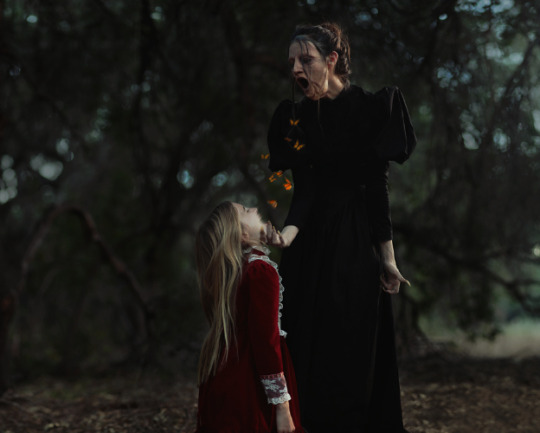
Alex has many reoccurring factors within the images that he composes such as, shooting women and girls, using water as an element in his photos, often the setting is cloudy or there is a blue filter, and he likes to shoot himself. Shooting women and girls is a very reoccurring theme that we see inn Alex’s images, throughout my research I do not think that I have found one photo of a man that isn’t himself. I have not found many answers of why he uses women, but if I were to guess it is because of what women symbolize. From an artistic perspective, women often represent beauty, purity, and innocence and I believe that is just how Alex is representing them, less in a position of power.
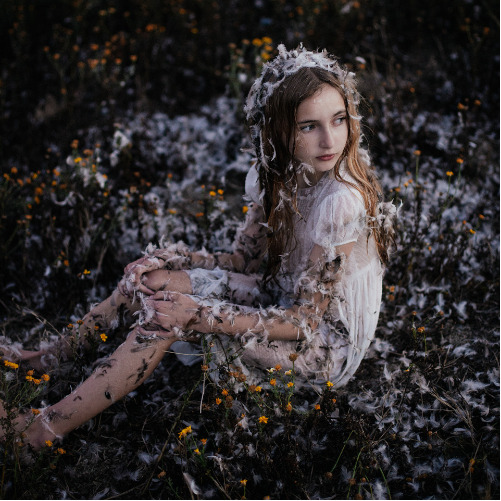
“Fledgling”
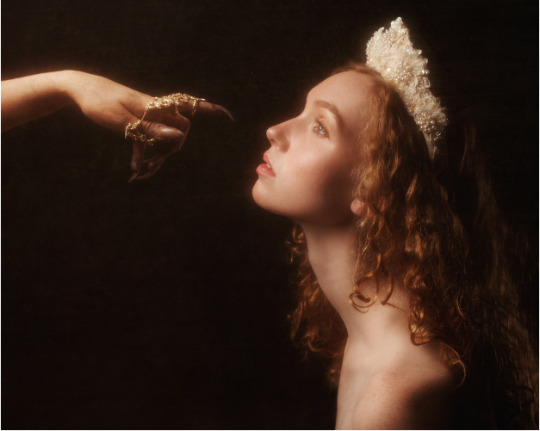
No.5 from “Take the Throne”

No.2 from “Hunting for Pearls”
Alex also frequently uses water in his photos for effect. Water to me is a very mysterious, powerful, and beautiful thing, Alex sometimes uses water to create an effect of stopped time. Water does suit Alex’s eerie and dark theme because it is something so powerful and can take the life of anyone, no matter how strong. Another thing that I think Alex uses water for is to evoke an uncomfortable feeling in the viewer, wet, dark, and mysterious is not only something to fear but also to intrigue us.

“Swallowed Up”

“The Queen’s Sentinels”

“Swimming Upstream”
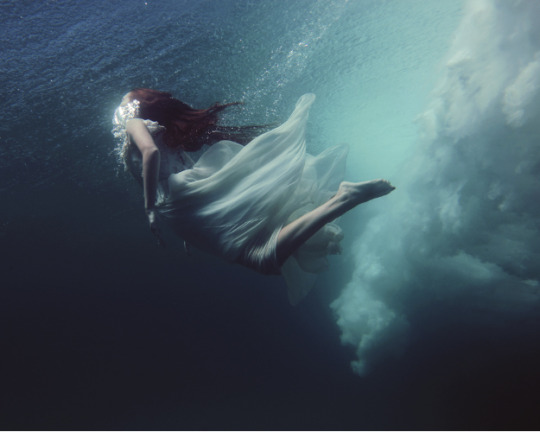
“Far from Air”
Alex will shoot on cloudy days or use a blue filter to create that spooky effect. Something about misty, rainy weather is unnerving to people and some, such as myself, love that effect, I know Alex is one of these people.
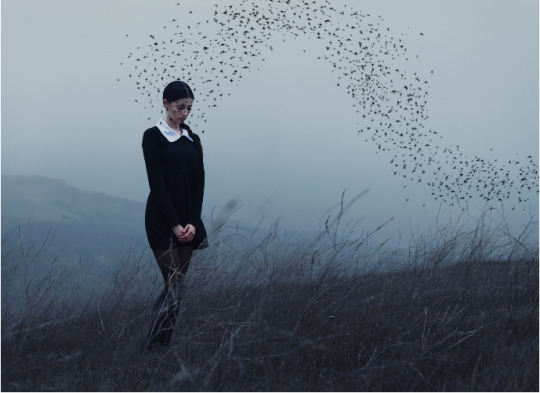
No.1 from “In the Wake of Thunder”
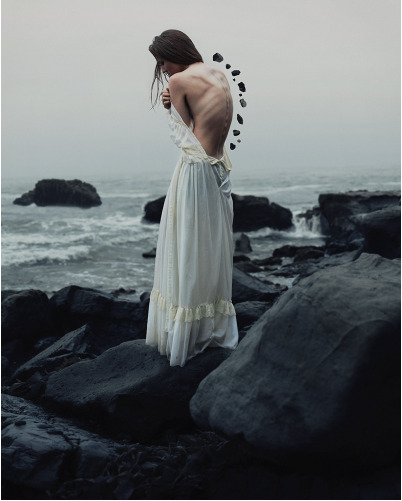
“The Shape She Makes”
One of Alex’s main subjects is himself, when Alex first began photography at sixteen, he would shoot himself and this has carried out for his entire career. Throughout my research, I have not seen any male models other than Alex, I think Alex uses himself as a model because you cannot escape yourself. When Alex needs a model, he will use himself, which means he can experiment with any crazy ideas without the fear of a model rejecting him. Not only are self-portraits an easy choice but I think Alex uses self-portraits as an artistic choice as well. Only Alex knows how he feels and only he can truly express himself by using himself as a main subject. Something that Alex will often do in his self-portraits is expose is expose his bottom, this seems as though he wants to show himself as very vulnerable. Alex uses many reoccurring theme in his work that would make me consider it to be an auteur.

“Dying Angels”

“The Air Up There”

“If Man were Meant to Fly”

“Thousand Year Burden”
Alex has reoccurring themes throughout his stand-alone portrait, his self-portraits, and his series. I believe that Alex’s work is an auteur because when you look at his work you a tell that it belongs to him. A style so identifiable that you can see who is belongs to by looking at it; this is exactly what Alex’s work holds.
0 notes